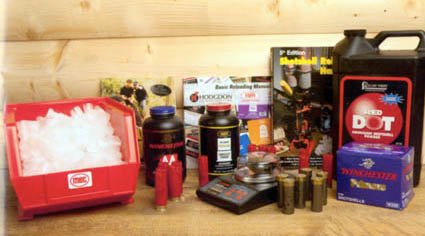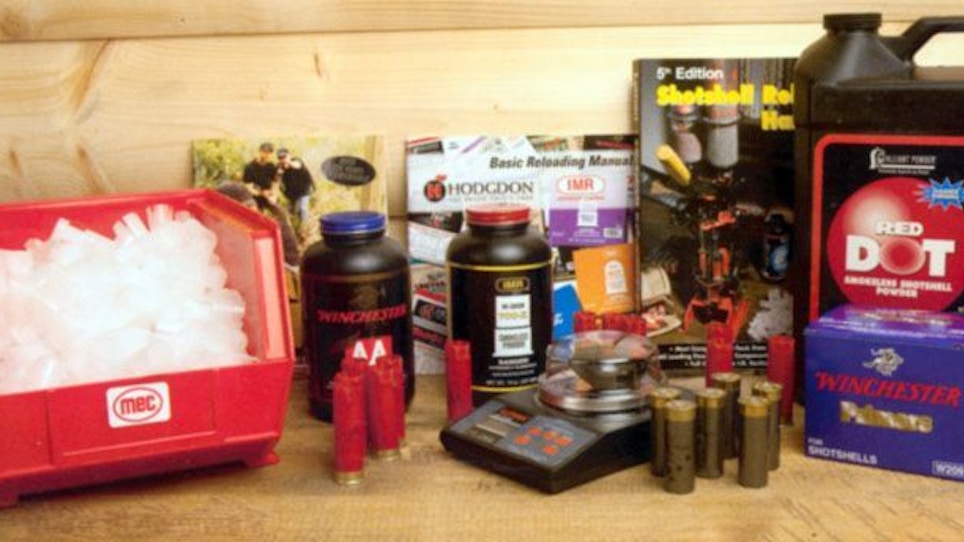 A selection of the components needed when you begin the process of reloading shotshells. |
A shotshell is made up of several different components (Click Here to go to Part 2 –Inside a Shotshell). There are many different variations of each component. Literature available from leading component manufacturers will show you the numerous combinations of primer, powder charge, and the wad and shot you should use with each empty hull for waterfowl, small game, trap, skeet, or sporting clays. Each combination of components has been carefully tested by ballistic experts for maximum effectiveness and safety. Experimenting with combinations that are not recommended by a component manufacturer is extremely dangerous!
Choosing the Hull. Proper choice of hulls is one of the most important decisions you must make to keep reloading simple. Not all hulls have the same capacity. Not all hulls have the same crimp. Each time you use a hull with a different capacity (usually caused by different base wad height) you must assemble a different set of components to properly fill the case. When starting to reload, choose the most popular of the low brass trap, skeet, or sporting clay hulls in your area and complement that hull with a set of components that fit. Usually, hulls can be purchased for a nominal amount, and when you consider that a modern plastic case can be reloaded many times, it adds very little to the cost of reloads. With the proper choice of components all loads – from the heaviest magnum down to the lightest skeet, trap, or sporting clays load – may be loaded in the same low brass hull.
The Shot. There are two kinds of shot – lead and non-toxic. Warning: Although lead and non-toxic shot are both easy to reload, it is absolutely essential that instructions for each are followed to the letter. For instance, never substitute non-toxic shot for lead shot. This could result in chamber pressure high enough to burst the gun, causing injury or death to the shooter or bystander. Wads that work fine with lead shot will not work with some non-toxic shot. When loading non-toxic shot, it is important that proper components are used according to directions furnished by the manufacturer. As the size of the shot increases, fewer pellets can be loaded in the hull. The smaller sizes are used for trap, skeet, sporting clays, doves, small game, etc. The larger shot sizes are used for heavier game – ducks, geese, turkey, etc.
Selecting the Right Wad. The wad is the part of the shotshell between the powder and the shot. A tight seal permits the expanding gas from the burning powder to push the shot column out of the gun barrel with maximum velocity. Modern “wad columns” combine both the shot cup and the wad in one piece. These one-piece wad columns are the easiest to reload, and therefore are the most popular. Use only the specific wad column recommended for the components you are using.
All powder is not alike. Different powders have different burn speeds, which make them useful for different jobs. The heavier the shot load, the slower the powder must burn. It takes longer to accelerate a heavy shot load than it does a light one. A fast-burning powder ignited behind a heavy shot load could lead to excessive “breech pressure” which might cause damage to the gun and even injury to the shooter. (Breech pressure is the pressure of the gas which is created by the burning powder; it is what forces the shot through the barrel.) On the other hand, using a slow-burning powder to propel a light load or shot will not work effectively. Without proper pressure buildup, many powders will not burn uniformly and impart sufficient velocity to the shot. Never substitute powders for non-toxic shot loads. Just because a powder will work well with 1-1/8 oz. of lead does not mean it will do the same with non-toxic shot.
Which Primer to Use? As noted previously, the primer ignites the powder. When the trigger is pulled, the hammer falls on the firing pin, denting the primer cup. This causes the component in the primer to detonate, igniting the main powder charge. Different primers have different characteristics depending on their purpose. Use only the primer recommended by the component manufacturers for the hull, powder, wad and shot load you are using.
Check out Part 1: Choosing the Right Reloading Tool
Check out Part 2: What's Really Inside a Shotshell
Check out Part 3: Selecting the Correct Reloading Components
Check out Part 4: Reloading Safety
Check out Part 5: Shotgun Reloading Steps
[Click Here for a list of manufacturers of Reloading Powders & Components.]
Article content and images provided courtesy of Mayville Engineering Company, Inc. (www.mecreloaders.com)






